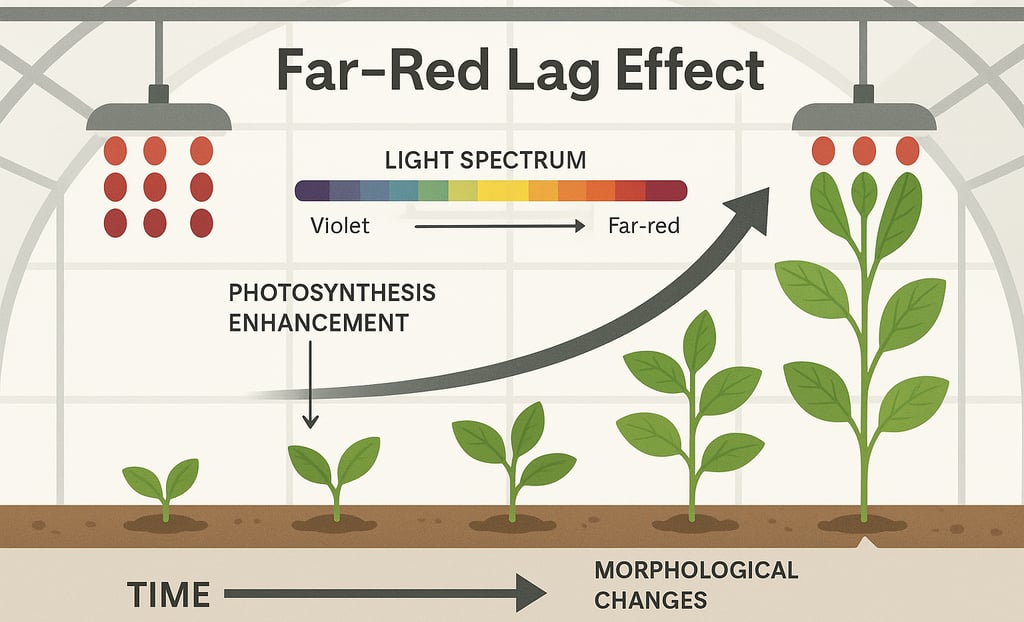The Far-Red Lag Effect: What Greenhouse Growers Need to Know to Boost Crop Production
FAR-RED LIGHTLETTUCESTRAWBERRYTOMATO
6/26/20253 min read


As a professional greenhouse grower, you know that light quality is just as important as light quantity for healthy, productive crops. One of the latest advances in lighting technology is the use of far-red light—a part of the light spectrum that can significantly improve plant growth and yield when used correctly. This article breaks down the far-red lag effect and how you can apply it practically in your greenhouse to get better results.
What Is Far-Red Light and the Far-Red Lag Effect?
Far-red light is light with wavelengths between 700 and 800 nanometers. It's just beyond the red light visible to our eyes.
Plants sense far-red light through special proteins called phytochromes, which tell them about their light environment.
The far-red lag effect means that when you add far-red light to your greenhouse lighting, the benefits (like faster growth or bigger plants) often show up after a delay—usually several days or weeks, not immediately.
Why Far-Red Light Matters: The Science Behind It
1. Boosting Photosynthesis (Emerson Enhancement Effect)
Plants use two photosystems (PSI and PSII) to convert light into energy.
Red light mainly powers PSII, while far-red light powers PSI.
When both red and far-red light are present, photosynthesis works better than with red light alone.
This means adding far-red light can increase the overall energy production of your plants, helping them grow faster and stronger.
2. Changing Plant Shape (Shade Avoidance Response)
Plants use the ratio of red to far-red light to detect if they are shaded by other plants.
More far-red light tells the plant it's shaded, triggering it to grow taller and stretch out leaves to capture more light.
In greenhouses, this can help improve airflow, light penetration, and ease of harvesting by changing plant shape in beneficial ways.
Real-World Success Stories
Lettuce
Studies show that adding far-red light to lettuce crops can increase dry weight by up to 40% in some varieties.
The biggest gains come from improved leaf expansion and better light capture.
For example, adding 30-50 µmol·m⁻²·s⁻¹ of far-red light to your existing LED setup can significantly boost growth.
Strawberries
Belgian growers using LED systems with far-red light report better stem and fruit truss elongation during winter months.
This makes it easier to harvest and improves fruit quality.
Far-red light helps varieties that tend to stay compact in low light conditions grow more open and productive.
Cucumbers and Other Vine Crops
Large-scale growers like Red Sun Farms Ontario are testing far-red lighting to improve internode length.
The dynamic lighting approach allows growers to adjust red-to-far-red ratios throughout different growth stages, maximizing benefits while avoiding potential drawbacks of excessive elongation
Tomatoes
Far-red light can increase seedling height and stem thickness.
However, results vary by variety and growing conditions, so it’s important to test on a small scale first.
Practical Tips for Using Far-Red Light in Your Greenhouse
Supplement, Don’t Replace: Far-red light works best when added to your existing red and blue LED lighting, not as a replacement.
Start with Moderate Levels: Around 30-50 µmol·m⁻²·s⁻¹ far-red intensity is effective for many crops.
Expect a Lag: Give plants at least 5-7 days to show growth responses after adding far-red light.
Adjust by Crop and Stage: Use more far-red during early growth stages to encourage leaf expansion and stem elongation; reduce it later if plants become too leggy.
Monitor Temperature and Environment: Far-red effects can vary depending on temperature and overall greenhouse conditions.
Use Dynamic Lighting if Possible: Systems that adjust far-red light throughout the day or growth cycle can maximize benefits and save energy.
Energy and Cost Considerations
Adding far-red LEDs means extra energy use, but the Emerson Enhancement Effect means you get more photosynthesis per photon, which can offset costs. Dynamic lighting systems help by only adding far-red light when plants need it most, improving energy efficiency.
Final Thoughts for Growers
The far-red lag effect is a powerful tool for greenhouse growers who want to improve crop quality and yield. While it requires some patience and fine-tuning, the benefits—better photosynthesis, improved plant shape, and increased productivity—make it worth exploring.
If you’re considering adding far-red light to your greenhouse, start with small trials on your key crops, monitor growth carefully, and adjust your lighting strategy based on results. As more growers adopt this technology, far-red lighting is set to become a standard part of modern, efficient greenhouse production.
Sources
Emerson, R. (1957). "Dependence of yield of photosynthesis in long-wave red on wavelength and intensity of supplementary light." Science.
Signify research on far-red in strawberry production, and with Wageningen University on tomato.
Red Sun Farms Ontario trials with dynamic far-red lighting for cucumbers.
Peer-reviewed studies on far-red supplementation in greenhouse crops:
